The market for wings is developing at lightning speed. In particular, a lot of attention is paid to lighter and stronger material to improve the performance and longevity of wings. We had the privilege of having Freewing’s performance wing, the Freewing Air Team 4.5m2, at our disposal all winter. Especially during our trip to Cadiz and Tarifa in Spain we got to know this wing really well. Read our findings and how to best tune this wing in this article.
Freewing Team Air | Sizes 3.0 m2 to 6.0m2 | Prices: € 1,489 to € 2,059 | Material: Hoókipa Ultra PE & Exclusive Ultra X Canopy
Freewing Air Team premium performance version standard Freewing Air
This new wing can be seen as a premium performance wing of the regular Freewing Air (V4). This is still a very versatile all-round wing. Only the performance and lifespan of this wing should be many times better than the regular Freewing Air. As standard, the wing is equipped with pre-preg carbon handles that are equipped with a thin grip. You also get a neat backpack where you can easily attach your pump and a nice leash.
The material looks markedly different. It also looks sturdier and less fragile. We have known for a long time that the X-ply, which is incorporated into the fabric, reduces the risk of tearing and that it provides a more stable pressure point. What is also striking is the enormous (maximum) pressure that goes into the airframes. In the 4.5 m2 that we have, the recommended pressure is 16 PSI. More about that later.
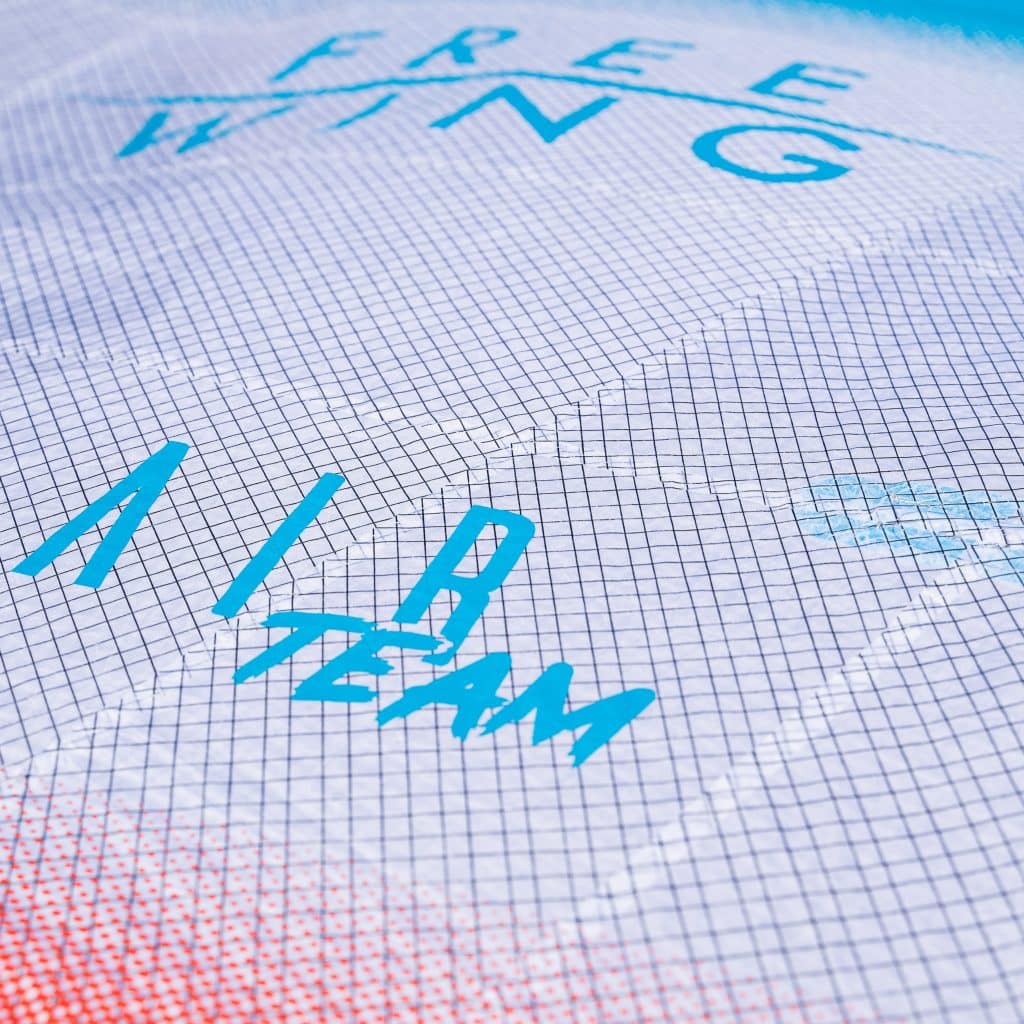
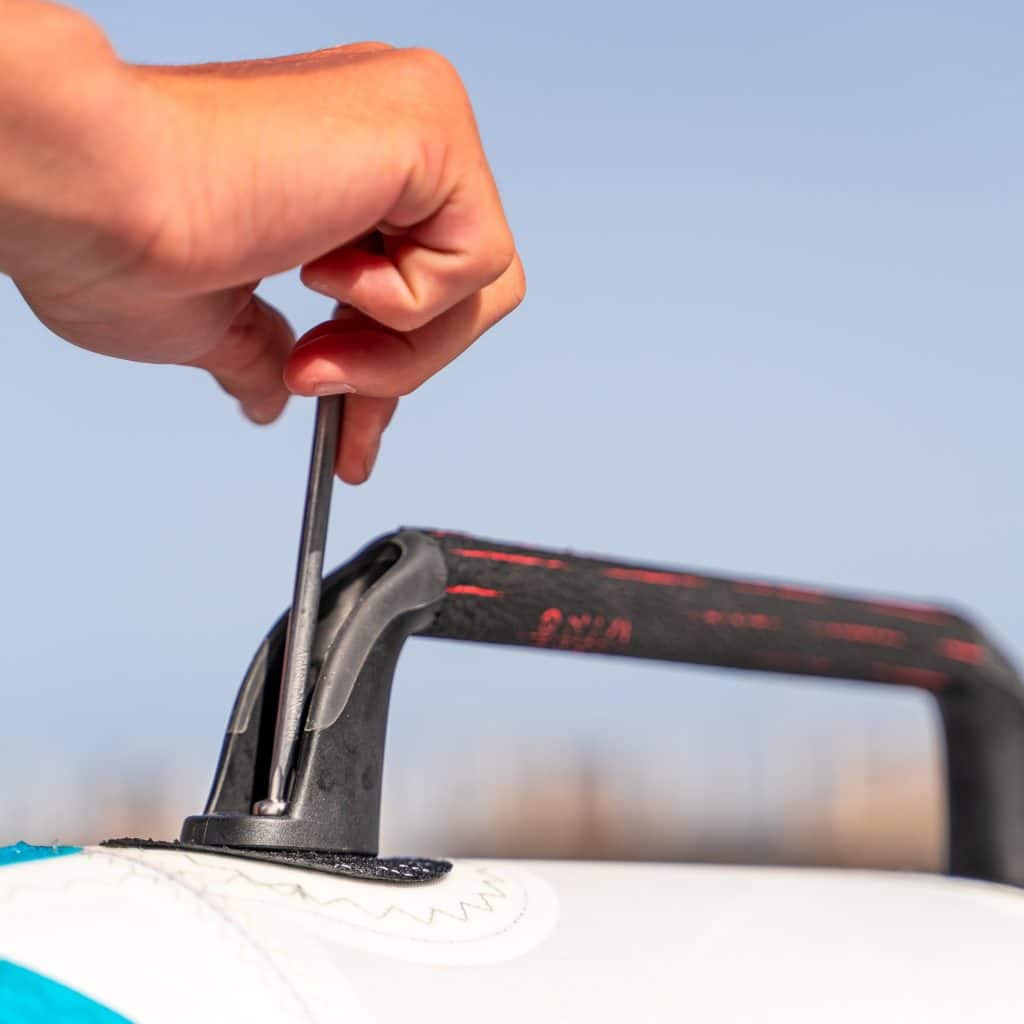
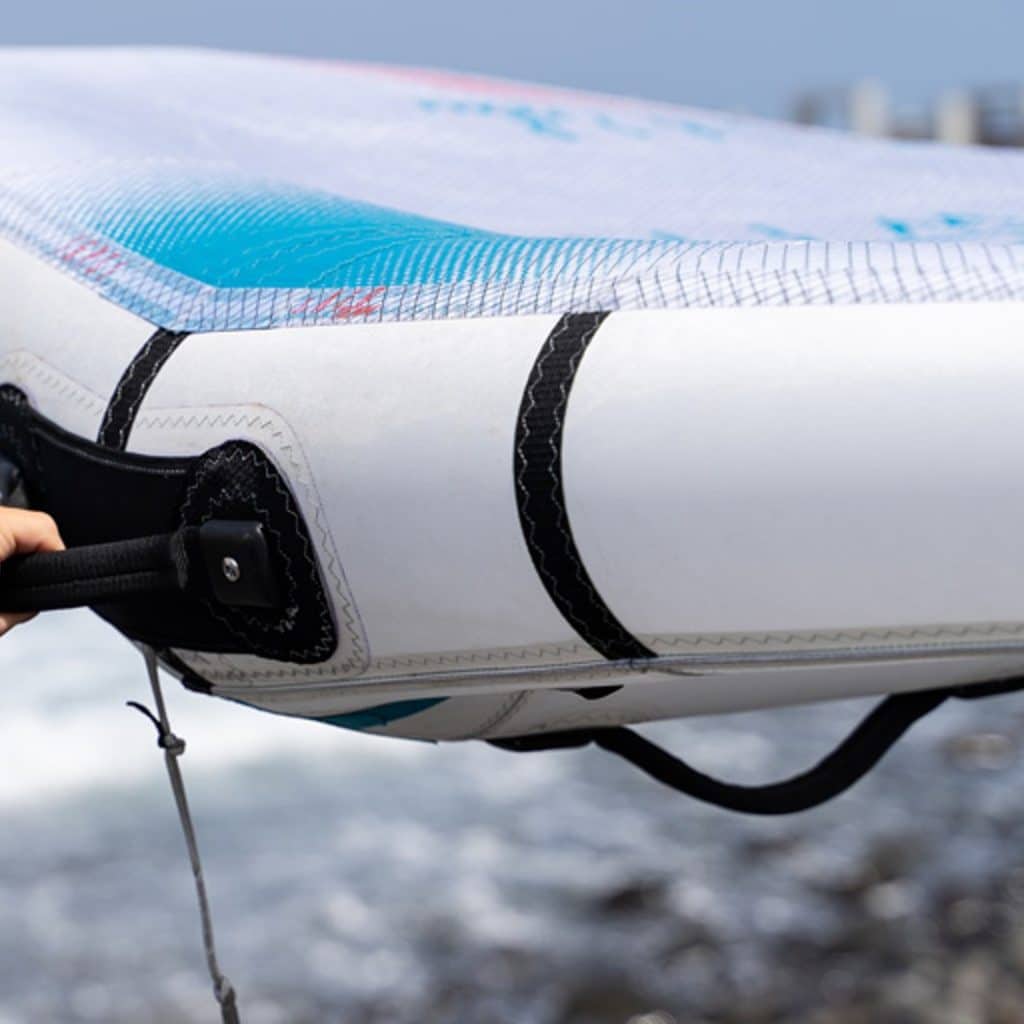
After we have inflated the wing, we notice how thin the airframes are and how flat the profile of the wing is. The trailing edge is also pretty tight. Many wings, on the other hand, have an open trailing edge. We initially inflated the airframes (both center strut and main strut) to 12 PSI.
Many of the elements, such as the material, the high pressure and the relatively dense trailing edge, we have already seen last year with the Freewing X-15 race wings that we tested on Lake Garda. Those wings were very stable and gave a lot of power. We’re curious to see how this all-round wing performs.
Dead feeling with recommended pressure in airframes
After we have pumped this up to the recommended number of PSI, we go out on the water. The first session is with 12 to 14 knots of wind. Immediately we notice that the wing feels very stiff and numb. Due to the rigid airframe, every pump movement is immediately converted into speed. Despite the ‘dead’ feeling, we can easily get on the foil. Once on the foil, we immediately feel how stable the wing is and how much forward pressure this wing gives.
The acceleration is really very good. The wing keeps dragging on it despite the fact that the wind is not even that strong. The pressure, the power is comparable to at least 5.0m2. Despite the power, the wing doesn’t feel heavy. This is because the pressure point is in a nice place and stays there.
Other than that, the feeling remains a bit dead. When we ‘play’ on the waves, we don’t get the ‘free’ and playful feeling that we do experience with the regular Freewing Air, for example. Gybing is very easy. The balance in the wing remains nice and the wing feels light. As a result, the transitions run very smoothly. Also a bit distant.
Perfect feel and balance at approx. 9 PSI main strut
Just like with windsurfing or wind foiling, you can also trim the wing. By playing with the pressure in the tubes, you can tune the wing (see more about tuning at the bottom of the article). We know from experience that a difference of 2 PSI can make a world of difference. That’s why we’re going to experiment with the pressure in the main strut (we don’t change pressure in center strut). After some trial and error we go back on the water for 9 PSI. At the first pump stroke you immediately notice the difference. It’s as if we have a completely different wing in our hands.
There is more feel in the pump strokes. With each pumping movement, the center strut bends slightly, allowing the wing to ‘breathe’ better. As a result, the effectiveness of pumping is much better. On the foil, the wing also feels livelier and lighter. The enormous stability and forward pressure of the wing has remained. It now feels like we are more at one with the wing. Now it’s fun to play in the waves and our transitions are also much more emotional. That’s what makes wing foiling so cool, right? The playful and free feeling and being 1 with the elements. Now it’s all right!
With this set-up, the deployment range of the wing is maximum and a lot larger than a regular Freewing Air. We like to wing with the smallest possible wing in our hands and we don’t need larger than 4.5 m2. Especially with a front wing of about 1000 cm2, you can easily get on the foil with about 10 knots.
Now that we have found the sweet spot in the Air Team, we enjoy this wing to the fullest. The power and stability are phenomenal and improve performance in every way. Whether it’s top speed, handling, freeriding or carving. You notice that the ‘drive’ now has much more power and is more accurate. As far as we are concerned, for that reason the Freewing Air Team more than worth its extra price.
We have also used the wing with a lot of wind at sea with big waves and even then the wing remains a pleasure. Even then, the stability of the wing ensures that you can remain stable wing foiling even in overpowered conditions.
Versatile, for racing and freestyle
Partly by tuning the wing, we can strongly influence the character. What’s always there is forward power. That makes this wing suitable for racing. Stability and a flat profile with plenty of forward pressure. With the right foil, this wing is really fast and we can keep up with the IQfoil wind foil youth in the upwind. Our top speed (with a freeride foil) is just over 44 km/h and upwind we reach a max of about 33 km/h!
On the other hand, with a little less pressure in the main strut, this wing is very lively and light-footed and freeriding, freestyling, wave riding is really a pleasure. Especially if you choose a slightly smaller size, you have maximum manoeuvrability, with good stability and more than enough power. And despite the high power in the wing, the Freewing Air Team is also easy to control in overpowered conditions because the profile remains stable in place.
Who is the Freewing Air Team for?
We think that because of the fine features of this wing, the Air Team appeals to a wide group of wing foilers. From both the speed-oriented wingfoiler and the freerider/freestyler.
If you are looking for better performance and more power, then the step to the Freewing Air Team is definitely worth considering. Add to that the stronger and more durable construction and the investment easily translates into many flying hours.
The speed/race oriented wing foiler is best suited for sizes 5.0 m2 and larger. The freerider/freestyler where manoeuvrability and a playful and light sensitive is more likely to go for the 4.5 m2 (for light wind) or smaller.
-
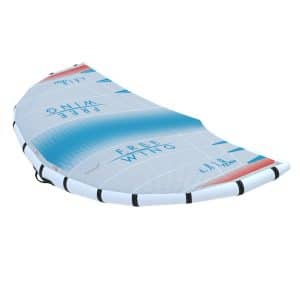
Freewing Air Team
€1.489,00 – €2.059,00 incl. VAT Select options This product has multiple variants. The options may be chosen on the product page
Tuning wings
We already wrote above about the impact of changing the pressure in the airframes. We’re going to take a closer look at how to tune wings. The airframes can literally be divided into 2 frames; 1) The center strut and 2) The main strut. With most wings, these are separate tubes and you have to inflate them separately or you can squeeze the connecting tube shut.
The center strut is the part of the airframe where the handles are attached and that provides direct contact with the wing. Our experience is that you always inflate the center strut to the maximum pressure, so that this part is as stiff as possible for the most direct transmission and feel possible.
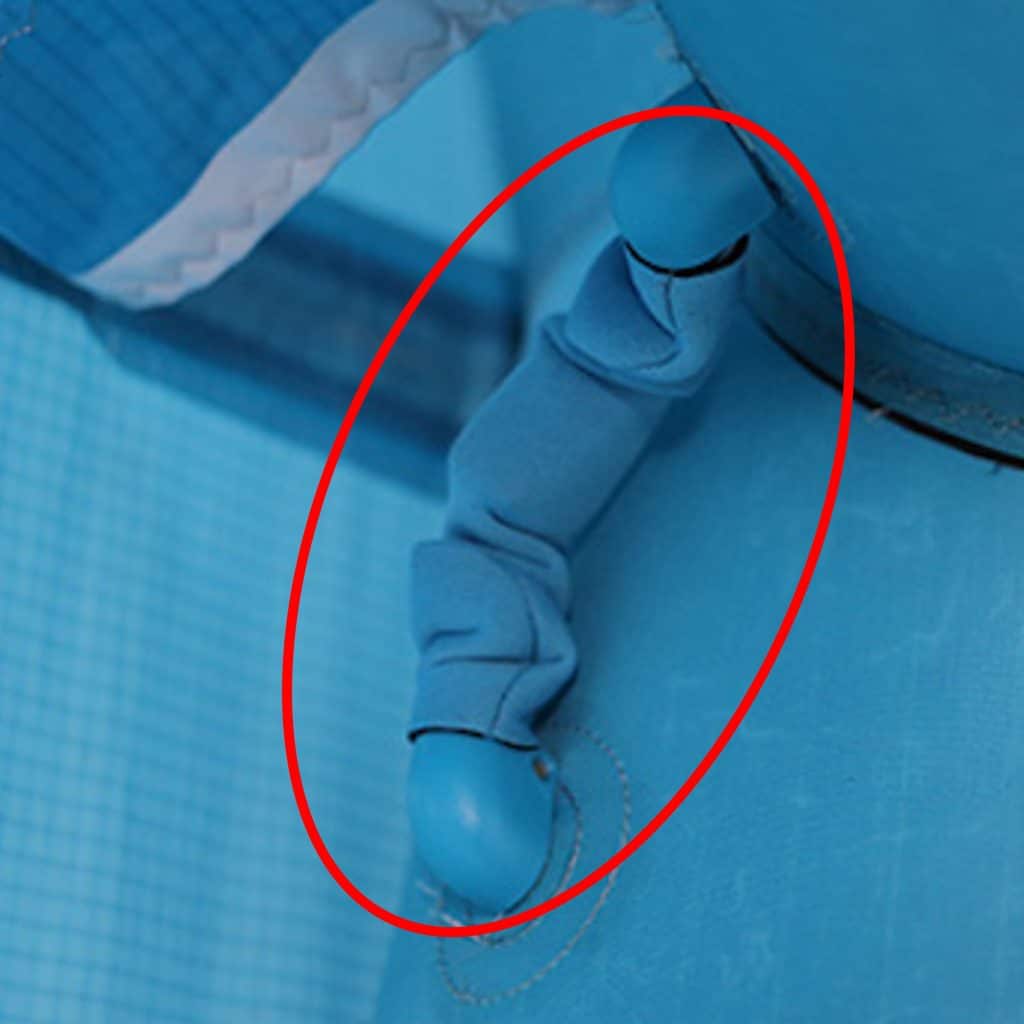
The main strut (leading edge) is a different story. If you pump maximum pressure into the main strut, a very stiff construction is created where the fabric is the tightest, especially the trailing edge. This can cause the wing to feel like a rigid ‘plate’ where the pressure point is also less noticeable and sometimes not very stable. It also ensures that the main strut bends relatively little when pumping. Actually, you can say that the wing does not really cooperate in moving the maximum amount of air with the pumping. This is especially true for the modern wings, which on average can handle a much higher maximum pressure than the older generation wings.
If the wind is blowing very hard and you want maximum control, then a stiffer construction is nice. The stiffer construction ensures a stable pressure point (with maximum load in the wing) and if the shape of the wing is right, this ensures a very constant and maximum forward pressure. Ideal for racing and upwind foiling. But as described, you do sacrifice a lot on feeling and liveliness.
Recommended number of PSI in main strut
Our advice is to adjust the pressure of the main strut to your own style and conditions. In many cases, a wing feels nicer if you reduce the pressure by about 15% to 25%. In the Air Team, we’ve never had more than 9 to 11 PSI in the main tube and never lower than 8 PSI.
Please note that this only applies to wings that indicate a maximum pressure of approximately 9 PSI or higher. If you have a wing that can handle a maximum of 8 PSI, a lower pressure will result in a main strut that is too weak, which will actually create the opposite effect. In particular, the wing will bend and move little air when pumping.
Because every wing is different and every wing reacts differently to changes in the pressure in the main strut, it is difficult to give a ‘hard’ number. Below is a guideline as a starting point for further fine-tuning;
- Little wind, up to 25% less pressure in main strut
- For freeriding, playful feeling in the wing, approx. 15% to 20% less pressure in the tube
- For racing with a lot of wind, you can stick to the recommended maximum pressure
- In overpowered conditions, you can maintain about the recommended maximum pressure or a few percent less
In general, the higher the maximum pressure the main strut can have, the more you can tune the wing.
Experience the good performance of the Air Team for yourself
We have the Freewing Air Team 4.5 m2 available in our test center to try out. If you are interested or would like to schedule a test appointment, please feel free to send us an email. We are also happy to help you tune your wing.


